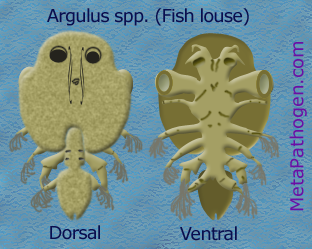Argulus sp., fish louse
Argulids are obligate fish ectoparasites, commonly called fish lice. In wild populations where the parasite's burden is low, it usually does not cause death. However, the infection increases susceptibility of the fish to bacterial pathogens such as Flavobacterium columnare which can lower survival rates.
In closed systems (ponds, fish farms, ornamental fish tanks) argulid species can pose a substantial threat to fish health and survival. Under artificial conditions Argulus spp. are known to cause large economic loss for fish farms where they are able to destroy fish very quickly.
Argulids are quite large and are easily observed by naked eye. For example, Argulus japonicus body average length is 6.5 mm for females, and 3.6 mm for males.
Argulus species were extensively studied. However, many aspects of their life cycle and physiology remain unknown and being disputed.
Argulus species cause skin lesions by their suckers and proboscis while feeding. The lesions can be infected by bacteria. The infection also causes reduced appetite, weight loss and anemia in fish. Argulus can be a vector of some viruses and parasitic nematode larvae.
Best known species
Argulus foliaceus prefers to parasitize percids and cyprinids. The species is widely spread in temperate zones and frequently found in shipments of ornamental tropical fish. Their vision in combination with olfaction and mechanoreception in the dark provide the highest host searching rate.
Argulus coregoni is an important parasite that infects mostly salmonids. Oncorhynchus mykiss is a typical salmonid host for this species. The boreal A. coregoni relies primarily on vision when searching for the host and is most active in transparent waters during long polar days in summer. Very young A. coregoni readily infects roach (Rutilus rutilus) because of non-specific visual stimulus of the roach's coloration (white disc over dark background). The initial preference of the parasites for brighter roach, changes at the age of 2 weeks (at the size of about 2 mm) for duller trout. However, when the main salmonid hosts are rare or temporarily missing A. coregoni can complete its life cycle on cyprinids. In wild populations the parasite burden is relatively low (less than one parasite per fish). According to studies in Central Finland, usually one main generation occurs annually.
Argulus japonicus Thiele, 1900 is an exotic fish parasite species was originally described in China, and later, it has spread to Europe, Africa, Australia, and North America through the importation of carp and gold fish.
Argulus izintwala was identified in lake St. Lucia, Africa. This species was only recorded to parasitize the clupeoid Hilsa kelee (mainly an inshore and pelagic species).
Argulus kosus is an argulid from Lake St. Lucia. It was collected from eight different hosts including freshwater, estuarine and marine species of fish.
Methods for control
salt (NaCl)
formaldehyde
potassium permanganate
powered quicklime
formalin
trichlorfon
emamectin benzoate
dimilin
Developmental stages
Life Cycle Stages
Argulus spp. reproduce sexually and male and female parasites mate on or off the host. Several matings may take place. Sperm is stored in the female's spematheca and used to fertilize eggs individually upon laying.
The generalized model of the dynamics of A. japonicus population in still-water trout fisheries in England suggests that 2 full generations of the parasite can occur in a year. The parasites overwinter either as hatched stages or dormant eggs.
Egg
Argulids deposit eggs in clutches on bottom of the water reservoir. A. foliaceus lays its eggs off the host on a firm surface in batches comprising 2-4 rows, with each batch containing up to 400 eggs. Although the parasite can lay eggs up to 10 times, the majority only lay once. Incubation time of the eggs ranges from approx. 20 (at about 18°C) days to approx. 40 days (at about 10-11°C). At temperatures below 10°C, eggs of A. foliaceus appear to lay dormant, allowing them overwinter for 4-6 months.
Larval
Hatching stage; early free-swiming pelagic, presumably non-feeding stage; also sometimes called metanauplius; lasts up to 6 days in A. foliaceus; at the end of the stage larva either dies (if no host was found) or attaches itself to the host and molts; the stage is absent in some species of argulids that hatch as a juveniles morphologically. A. foliaceus metanauplius is 0.8 μm in length.
Juvenile
Sexually immature actively feeding fish louse. It takes from 34 to 80 days for A. foliaceus to develop from hatching to adult depending on the temperature. The juveniles molt as they grow.
Adult
Sexually mature fish louse. When A. foliaceus reaches 4.7 mm in length it is considered to be adult and capable of laying eggs.
